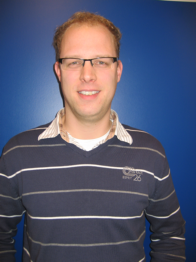Hybrid Magnetometers for Unshielded Operation: Combining Hall Sensors with Superconducting Flux Concentrators
Promotion date: 16. April 2010
Promotor: Prof. Dr. Horst Rogalla
Assistant Promotors: Dr. Ir. Jaap Flokstra
| Hybrid magnetometers consisting of a normal conducting Hall sensor and a superconducting flux concentrator, have been investigated. The operation of such sensors in an unshielded environment gives rise to 1/f noise, due to trapped vortices in the superconducting body. A new model for the critical field of vortex trapping in thin film strips, has been derived and experimentally verified by scanning SQUID microscope measurements. |
Were your research activities application minded or orientated towards fundamental science more?
The research was intended to be application minded, since a magnetic field sensor suitable for space applications should be developed. During the research interesting fundamental issues arose, while studying the operation of such sensors in an unshielded environment.
Hybrid magnetometers might be interesting for upcoming space missions, as they are very small, light in weight and have low power consumption. Moreover, the readout of such sensors is relatively easy and straightforward.
We tried to integrate superconducting and semiconducting materials in one device. We used a semiconductor Hall element as a magnetic field sensor and we enhanced the sensitivity with a superconducting flux concentrator to give it the required sensitivity for space applications. Superconducting materials only become superconducting at very low temperatures. The integration of superconducting materials with everyday semiconductor-technology, and the operation at very low temperatures, is far from trivial at some points.
Furthermore, we investigated the trapping of very small so-called flux vortices in the superconducting body. These vortices have a negative effect on the noise properties of the device and are therefore unwanted. It is possible to divide the superconducting body into narrow strips. These have a certain critical field below which no vortex trapping occurs. We developed a new theory which predicts the critical field for vortex trapping.
Measurements have been carried out with a scanning SQUID-microscope which showed very good correspondence with the model. We were helped a great deal by professor John Kirtley from IBM. The specialized microscope was offered by him to our group when he finished working there.
Were you able to publish some of your findings?
Yes, we had a paper published in Physical Review B in January 2008 which is probably the most important one. We also had papers in IEEE, Transactions on Applied Superconductivity, Sensor Letters and Superconducting Science and Technology. Furthermore, we were at numerous conferences where we had orals and poster presentations.
I guess a lot of different techniques and measurements had to be carried out in this project?
The hybrid magnetometers were produced in the thin film laboratories and in the clean room, for the biggest part. The electrical characterization, on the other hand, was carried out mainly at our low temperature laboratory. This is also the place where the scanning SQUID microscope is located.
I owe special thanks to in total six bachelor students and two internship students, who performed segments of the project research all the way through. Two of them, for example, worked with John Kirtley on measuring the flux vortices. All of them had practical assignments and worked in the lab for a substantial part, getting to know all the fabrication and characterization techniques very well. Cooperation with students can be very helpful, I am convinced. Also this way of working is good for the students themselves, and indeed for the faculty and the university as a whole.
What are your future plans?
I prefer working in a R&D department of a company which can be small or large. Some interesting research jobs might be available at spin-off companies of the university, here in Twente. Research and development in these companies is application minded and that appeals to me. My goal is to become a senior researcher within a few years.

